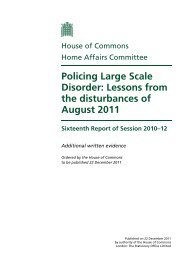Reducing Bureaucracy in Policing - Home Office
Reducing Bureaucracy in Policing - Home Office
Reducing Bureaucracy in Policing - Home Office
Create successful ePaper yourself
Turn your PDF publications into a flip-book with our unique Google optimized e-Paper software.
Added bureaucracy is created where clear purpose is not def<strong>in</strong>ed. Whilst it is important to<br />
measure performance, to know what works and cont<strong>in</strong>ually improve, over-reliance on measures<br />
which are easy to count skew true performance and, as demonstrated <strong>in</strong> the <strong>in</strong>itiative from<br />
Cheshire below, can be counter-productive. Such an approach can take the heart out of polic<strong>in</strong>g,<br />
particularly where philanthropic values are replaced by calculators, where activity becomes a unit<br />
of efficiency and where we know the price of everyth<strong>in</strong>g and the value of noth<strong>in</strong>g. Where process<br />
dictates the way we operate, where ‘do<strong>in</strong>g the th<strong>in</strong>g right’, accord<strong>in</strong>g to the prescribed rules laid<br />
down, is more important than ‘do<strong>in</strong>g the right th<strong>in</strong>g’. The rules become more important than the<br />
outcomes.<br />
There is a need to develop a new type of knowledge base which records solutions to 'real<br />
community problems', identifies what works and "good practice" to balance disproportionate<br />
attention given to crime statistics.<br />
In try<strong>in</strong>g to def<strong>in</strong>e purpose Sir Robert Peel’s polic<strong>in</strong>g pr<strong>in</strong>ciples 4 are often referred to. Peel placed<br />
prevention of crime and disorder <strong>in</strong> first place, closely followed by polic<strong>in</strong>g by consent and be<strong>in</strong>g<br />
answerable to the law. The test of efficiency for Peel was the absence of crime and disorder, ‘not<br />
the visible evidence of police action <strong>in</strong> deal<strong>in</strong>g with them’. Peel is <strong>in</strong>formative, but systems struggle<br />
to demonstrate prevention. The <strong>Home</strong> Secretary has recently sought to re-focus polic<strong>in</strong>g away<br />
from the multitude of targets to one of reduc<strong>in</strong>g crime. In do<strong>in</strong>g so she will want to ensure the<br />
examples above do not go unrecognised and that police respond appropriately and proportionately<br />
to local problems.<br />
Liv<strong>in</strong>g <strong>in</strong> a competitive world, it is questionable how <strong>in</strong>formative comparative data between forces<br />
is. As an <strong>in</strong>dicator it has its place but care must be taken to ensure greater attention is not given to<br />
present<strong>in</strong>g statistics <strong>in</strong> the most positive light, than mak<strong>in</strong>g communities safer.<br />
Despite announcements to remove the vast majority of targets and other de facto measures, few<br />
front l<strong>in</strong>e officers have experienced a reduction <strong>in</strong> the number of personal or team performance<br />
<strong>in</strong>dicators. Quantitative <strong>in</strong>dicators such as the number of arrests, stops, <strong>in</strong>telligence reports etc are<br />
still rout<strong>in</strong>ely collected and collated at a local level, frequently without the apparent knowledge or<br />
approval of chief officers.<br />
A significant number of officers ga<strong>in</strong>ed their early years experience <strong>in</strong> polic<strong>in</strong>g meet<strong>in</strong>g onedimensional<br />
targets.They will need support and guidance to adopt a more problem-solv<strong>in</strong>g<br />
approach. Sergeants and Inspectors cont<strong>in</strong>ue to report the requirement to demonstrate full<br />
compliance with set procedures and standards rather than the ability to apply a more<br />
proportionate, problem solv<strong>in</strong>g approach based on values and respond<strong>in</strong>g to community needs.<br />
There is a strong feel<strong>in</strong>g that activity which is easy to count gets recognised, with little recognition<br />
of quality or time taken to resolve <strong>in</strong>cidents such as reassurance polic<strong>in</strong>g, deal<strong>in</strong>g with traumatic<br />
<strong>in</strong>cidents or preventative polic<strong>in</strong>g. In forces where the target culture is strong there is little ability to<br />
use discretion or professional judgement as this is not formally recognised nationally.<br />
Cheshire police have sought to better understand and respond to local<br />
community needs. Research <strong>in</strong>dicated police made assumptions about local<br />
demand and determ<strong>in</strong>ed priorities to feed the performance framework. They<br />
analysed 22,000 calls for “service” (calls received, messages left for<br />
neighbourhood officers, face to face contact with members of the public etc.) to<br />
understand what was be<strong>in</strong>g requested. They found calls were quickly categorised<br />
accord<strong>in</strong>g to polic<strong>in</strong>g priorities (how measured), but not necessarily <strong>in</strong> a way that<br />
responded to the problem. Further analysis identified up to 41% of calls received<br />
4 New Westm<strong>in</strong>ster Police Service: “Sir Robert Peel N<strong>in</strong>e Pr<strong>in</strong>ciples” http.www.nwpolice.org/peel.html<br />
13

















